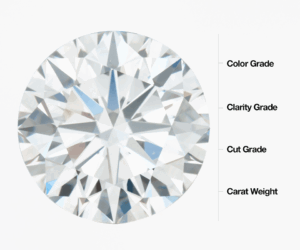What are the 4 Cs of Buying Diamonds?
Are you surprising your loved one with a stunning diamond? Are you and your partner looking for the perfect engagement ring gem? Understanding diamond basics – the 4 C’s – will guide you on how to choose a diamond, ensuring the ideal balance of quality and value.
The 4 C’s of Diamonds
Understanding basic facts about diamonds – such as their anatomy, grading, and value – can help you choose the perfect stone to be cherished throughout generations. The 4 C’s diamond guide includes various shapes and sizes and should harmonize to suit your needs and budget.
What are the 4 C’s of diamonds? The 4 C’s represent the stone’s carat, color, cut, and clarity.

The diamond cut, color, clarity, and carat represented in the 4 C’s chart provides a grading system on what to expect from a diamond. Additionally, relying on a trusted, knowledgeable resource is imperative. At JPratt Designs, we’re here to help.
Our 4 C’s diamond-buying guide explains your diamond specs and reminds you that no diamond is perfect. A stone rating high on every scale may not be ideal for your ring design, or you may find that carat outweighs color.
When buying loose diamonds, consider all 4 C’s in combination. Assess the gem’s natural appearance to determine which best suits your design. JPratt Designs utilizes the grading system and only sells Gemological Institute of America (GIA) standard stones.
Diamond Cut
A diamond’s cut quality is most crucial, as the cut produces the stone’s sparkle and brilliance. It’s the element most influenced by human hands and best noticed with the naked eye.
Types of Cuts
Diamond shape and cut are related but different. The cut impacts and refers to proportion, depth, symmetry, brilliance, and reflection.
Popular shapes and cuts include round, princess (square), emerald (square or rectangular), cushion (rounded square), oval, Asscher (squared off with layered facets), marquise (an elongated diamond shape), baguette (rectangular), radiant, and the unique trillion cut.
The round cut is the most popular, thanks to its shape and cut offering the most excellent reflection. The cushion shape is also well loved and has various options for a customized finish.
Diamond Cut Quality Guide
The quality of the cut of a diamond is determined by precision, symmetry, and polish, affecting how the diamond interacts with and reflects light. How the size and angles relate refers to precision, while symmetry is how well the facets intersect and line up. Polish is the finish and how the facet shapes are placed.
A poorly cut diamond may appear dull, even with good clarity and color. In contrast, a well-cut diamond maximizes sparkle and brightness. Diamond cuts are graded as “excellent,” “very good,” “good,” “fair,” and “poor.” We recommend the “excellent” to “very good” range.
Diamond Color
Color refers to the natural hue of white diamonds, ranging from colorless diamonds to yellow or yellow-brown stones. It’s measured on a D to Z scale, with “D” meaning colorless. Jewelers use a different grading system to measure other natural-colored diamonds, such as pink, blue, and red. Look for standard quality gems between the D-J color grade.
The shape also influences color ratings. For example, longer and oval-shaped diamonds show more yellow tones. Round diamonds disguise color well, so you can venture further down the scale without seeing yellowing.
Always check loose diamonds since cut, carat weight, and shape can influence the color’s appearance. While it’s tricky to tell the difference between two diamonds, their price reflects their rating on the color portion of the diamond 4 C’s chart. However, the final choice of diamond color depends on preference.
Diamond Clarity
Inclusions, blemishes, and internal and external features determine a diamond’s clarity rating, with most diamond characteristics only seen using magnification. A diamond without any inclusions or blemishes is rare.
The diamond cut and clarity chart grades stones based on slight differences, such as “flawless,” “very slightly included,” “slightly included,” or “contains inclusions.” Inclusions become more noticeable the farther down the color-cut-clarity chart.
The imperfection of inclusions and blemishes can interfere with the light shining through the gem, impacting the diamond’s brilliance and beauty. So, regardless of a high-quality cut, poorer clarity can dull the stone.
When assessing clarity, ensure each stone is eye clean, meaning flaws don’t interfere with light refraction. You can do this yourself — a reputable diamond professional can provide you a loupe to examine the gems. Tiny black dots on the diamond may be surface dirt or inclusions, making the diamond look “dirty.”
Diamond Carat
We often assume that the diamond’s size determines the carat. However, it’s based on the gem’s physical weight, with one carat equaling 0.2 grams. Diamonds with the same carat weight can have very different sizes, depending on the cut. Similarly, diamonds weighing the same can look different based on their shapes, such as oval, radiant, heart, pear, princess, and brilliant.
So if you prefer the biggest carat within your budget, you may have to compromise elsewhere. Consider how the carat compares to the other Cs. For example, a 1.5-carat diamond with inferior clarity and cut won’t have the sparkle of a 1.0-carat gem rated excellent on cut.
Using the 4 C’s to Buy the Perfect Diamond at JPratt Designs
Cut, clarity, color, and carat determine these precious stones’ quality, value, and beauty. However, differentiating each element without equipment can still be challenging. Instead, our knowledgeable and experienced jewelers can assist you. The team at JPratt Designs will steer you through every diamond assessment aspect to ensure the perfect stone for your budget and setting. Get in touch with us today.

